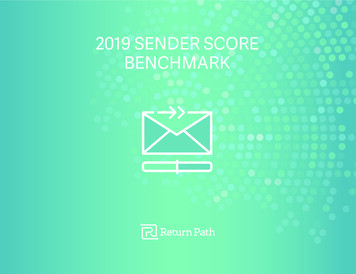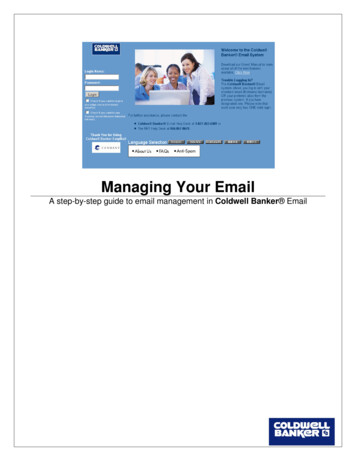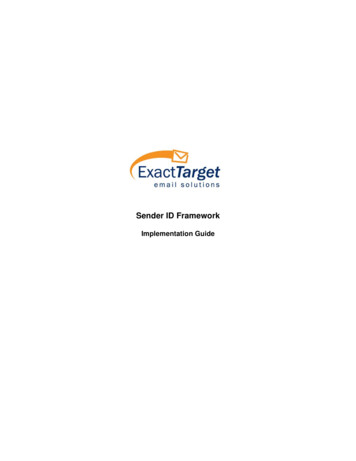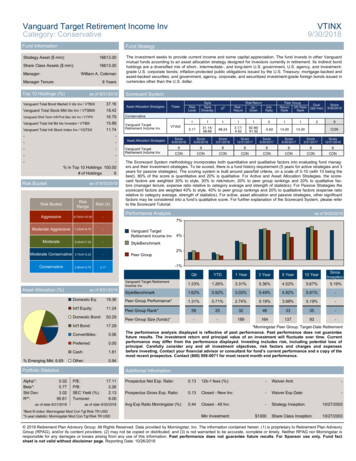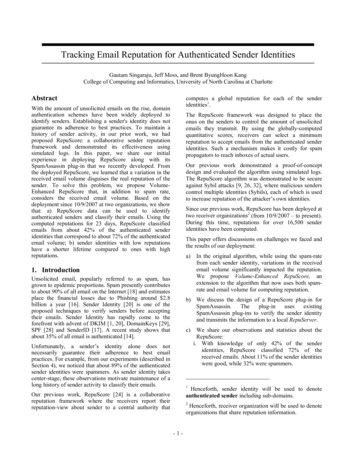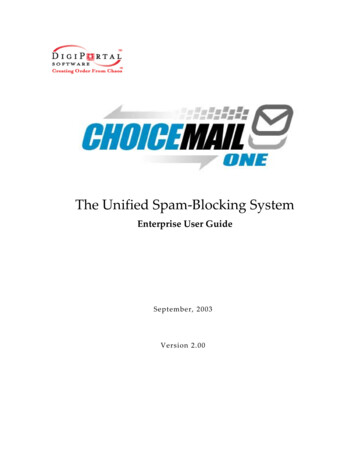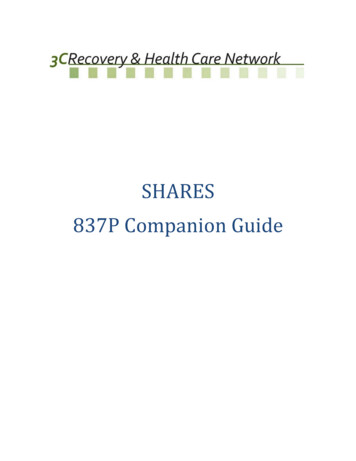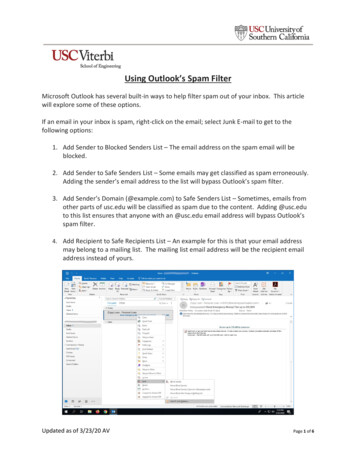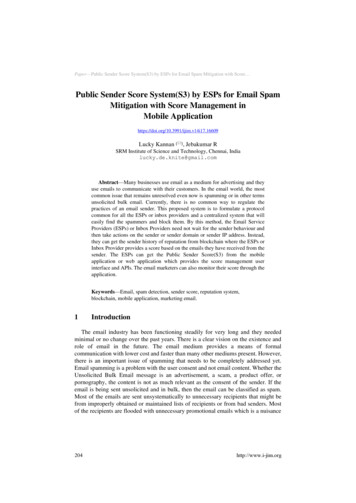
Transcription
Paper—Public Sender Score System(S3) by ESPs for Email Spam Mitigation with Score Public Sender Score System(S3) by ESPs for Email SpamMitigation with Score Management inMobile 09Lucky Kannan ( ), Jebakumar RSRM Institute of Science and Technology, Chennai, Indialucky.de.knite@gmail.comAbstract—Many businesses use email as a medium for advertising and theyuse emails to communicate with their customers. In the email world, the mostcommon issue that remains unresolved even now is spamming or in other termsunsolicited bulk email. Currently, there is no common way to regulate thepractices of an email sender. This proposed system is to formulate a protocolcommon for all the ESPs or inbox providers and a centralized system that willeasily find the spammers and block them. By this method, the Email ServiceProviders (ESPs) or Inbox Providers need not wait for the sender behaviour andthen take actions on the sender or sender domain or sender IP address. Instead,they can get the sender history of reputation from blockchain where the ESPs orInbox Provider provides a score based on the emails they have received from thesender. The ESPs can get the Public Sender Score(S3) from the mobileapplication or web application which provides the score management userinterface and APIs. The email marketers can also monitor their score through theapplication.Keywords—Email, spam detection, sender score, reputation system,blockchain, mobile application, marketing email.1IntroductionThe email industry has been functioning steadily for very long and they neededminimal or no change over the past years. There is a clear vision on the existence androle of email in the future. The email medium provides a means of formalcommunication with lower cost and faster than many other mediums present. However,there is an important issue of spamming that needs to be completely addressed yet.Email spamming is a problem with the user consent and not email content. Whether theUnsolicited Bulk Email message is an advertisement, a scam, a product offer, orpornography, the content is not as much relevant as the consent of the sender. If theemail is being sent unsolicited and in bulk, then the email can be classified as spam.Most of the emails are sent unsystematically to unnecessary recipients that might befrom improperly obtained or maintained lists of recipients or from bad senders. Mostof the recipients are flooded with unnecessary promotional emails which is a nuisance204http://www.i-jim.org
Paper—Public Sender Score System(S3) by ESPs for Email Spam Mitigation with Score to the recipients and also to the recipient email system as the disk storage space,computational resources and network bandwidth of the recipient email systems isconsumed. Events like this can lead to the annoyance of the recipients and they mightpermanently deny to accept these emails and as a result, the credibility of the businessof the sender may get destroyed. So, the violators of the basic rules of marketing ornewsletter have to be identified and make them stop their approach. Most of the spamidentification mechanisms like Machine Learning are done by the email providers as in[1] after the mail is received by them which is found to be very effective. There areclickbait detection mechanisms like [2] that identifies spammers too. Some contentdiffers from the subject and the spammers insert spam content in between the emailcontent which can be identified by mechanisms like [3]. There are a lot of othermechanisms in place by the email providers in order to identify spam in the emailcontent. This paper aims a different approach to stop the email spams at the origin evenbefore the emails are sent out to the recipients.In this paper, we propose a public Sender Score System (S3) that maintains thesender’s reputation by a score which is updated by the inbox providers periodically.The public server is either a decentralized blockchain or centralised server with anauthority. A sender score updation protocol has to be created which will be used by theinbox providers who will be updating or querying the score in the Sender Score System(S3). They are also used by the promotional email senders who will be querying thescore to know their own reputation.In Section II, the background information, the previous works to classify spamemails, and the sender verification processes and sender scores are discussed. SectionIII explains the research design and process diagram of the proposed public sender scoresystem with explanation. Section IV gives conclusion of the proposed design. Finally,Section V presents future directions of improving the sender score protocol andmanagement of the centralised or decentralised public sender score system.2Related WorksIn this section, we will discuss the previous works on giving weightage for the emailsender and calculating credibility of the emails using the sender information.2.1Sender email authenticationIn order to have better inbox reach, the senders have recently adopted all theauthentication mechanisms that were proposed which directly affects the authenticityand credibility of the emails sent by them. One of the mechanisms which is adoptedworldwide is Sender Policy Framework (SPF) [4] which prevents impostors byblocking the email if the SPF check fails. SPF allows the domain owners to specify whocan send emails from their domain which would reduce the risk of their domain beingcompromised.Another mechanism is Domain Keys Identified Mail (DKIM) Signatures [5] throughwhich the person that owns the signing domain can claim responsibility for a messageiJIM ‒ Vol. 14, No. 17, 2020205
Paper—Public Sender Score System(S3) by ESPs for Email Spam Mitigation with Score by associating the domain with the message. Using DKIM signature the recipientsystem can verify that the email is not tampered by checking the sign with the publickey in the DKIM record of the domain and the content of the email. The recipientsystem can also identify the responsible domain that signed the email.Another standardised mechanism called Domain-based Message Authentication,Reporting, and Conformance (DMARC) [6] is extremely powerful as a tool to stopemail spoofing. DMARC policies can be set on who can send email for your domainbased on DKIM and SPF. Along with SPF and DKIM, the DMARC policy in DNSallows the domain owner to set rules to reject or quarantine (junk folder) or do nothingto the emails from unknown sources.2.2Sender reputationThere are various methods that have been implemented over the years which areused to identify the bad senders. The sender domains and IP addresses have a senderreputation using which we can guess the quality of the emails from them.a) DMARC: There are various ways in which the sender is notified about theirreputation or email deliverability. Domain-based Message Authentication,Reporting, and Conformance (DMARC) method, which was discussed before, alsoallows the sender to get reports of their email delivery through an email which isspecified in the DMARC DNS TXT record [3].b) Feedback Loops: There are Feedback Loops (FBL) [7] [8] [9] provided by someMailbox Providers which will be useful for the marketing Email Service Providers.A large volume sender can use the FeedBack Loop (FBL) to identify emailcampaigns in its traffic that are getting a high volume of complaints from users ofthe Mailbox Providers. The FBL is useful to ESPs to detect abuse of their services.c) Reputation System: As Taylor [10] pointed out in the paper, there are reputationsystems with the Mailbox Providers that calculate the reputation of the sender andregulate the emails by classifying bad emails under spam or drop them. The systemsuse the connecting IP address to represent the sender. They use the sender score andalso send the message to a statistical spam filter and finally make a judgement on theemails.d) Postmaster Tools: Postmaster Tools [11] are provided by the Mailbox Provided forthe bulk email senders to check the deliverability of their emails and point out theissues in their problems in their deliverability. The tool is used to see if users aremarking sender emails as spam, to see the prevention method for sender’s emailsfrom being blocked, to see the reason for sender’s emails not being delivered, and tosee if the emails are sent securely.e) Domain Blacklist, Whitelist and History: Besides these different techniques, thereare several other methods to check by considering their sending histories. DomainName System White List (DNSWL) [12] is a central database that stores the senderswith better sending history. Domain Name System Blacklist (DNSBL) [13] [14] is acentral database which stores the senders list with bad sending history. WHOISprotocol [14] [15] is used to search for the Domain Name System (DNS) and Name206http://www.i-jim.org
Paper—Public Sender Score System(S3) by ESPs for Email Spam Mitigation with Score Server (NS) information of the sender. It provides more information about the ageof the sender domain which helps in finding the credibility of the message sent bythe sender.All of this and many other methods [16-18] are present which influences thereputation of the sender which in turn affects inbox delivery in the recipient system.But in all cases, the sender reputation is maintained separately in each recipient systemand there is no way to maintain a common reputation for the bulk sending system andtheir users yet.3Proposed SystemThere is a problem of blocking the bad users or sender from blocking as they mightkeep changing the sending service, when the sending service blocks them. So, they keepsending spam messages through a different service by switching instead of correctingtheir sending methods. This event is shown as a diagram in Fig. 1Fig. 1. Bad senders switching Bulk Sending SystemBy using the proposed system, this can be avoided by using the Public Sender ScoreSystem (S3). In this system, the senders of unsolicited bulk emails are blocked in thesending system instead of sending it to the recipients. The sending system checks S3(Public Sender Score System) for a Sender Score and a sender score history, and if thesender score does not seem to be proper, then they will block the user from sendingemails, until best practices are followed. By this way, the reputation of Sending Systemis not affected and the Recipient or Inbox Providing System does not receive theunsolicited emails. Even if the Inbox Providing system receives email, it can check theSender Score in the Public Sender Score System (S3) and take required action on theemail. This process is shown in the following illustration in Fig. 2iJIM ‒ Vol. 14, No. 17, 2020207
Paper—Public Sender Score System(S3) by ESPs for Email Spam Mitigation with Score Fig. 2. Bad users blocked by Bulk Sending SystemHere, the Public Sender Score System, shortly called as S3, can be either acentralised server or a decentralised blockchain. For this paper, in most of the cases, wewill assume that S3 (Public Sender Score System) is a decentralised blockchainimplementation which can be built using Ethereum [19]. There can be two blockchainsin this architecture in which one is maintained by the mailbox providers and the otheris maintained by the bulk email sending services. For this paper, in most of the cases,we will assume that there is one blockchain maintained by the email sending services.Fig. 3 shows the common architecture of the proposed system with all the differentelements involved in the system. It shows how the Public Sender Score System is usedalong with the other elements in email sending. It also shows where the Sender Scoreis updated and where the score is retrieved in the email sending ecosystem. Let usdiscuss the elements in the architecture.3.1Marketer or userMarketer or user is the origin of the email. Marketer has the bulk list of emails towhom they send the emails. So, their reputation is directly proportional to the credibilityof the emails. They should be solely responsible for any impact on the domainreputation, either positive or negative.3.2Bulk email service providerBulk Email Service Provider is an application or a service or a platform that helpsthe users to send out emails with ease. They would also make sure the right emails aresent to the right recipients. One way to make sure is through the feedback loops andpostmaster tool provided by the recipient system. So, by the time the bad sender isidentified, all the emails are probably sent and there is no reverting back. By the methodof the Public Sender Score system, the sender’s score and history is already present inS3 and the email providers are free to take a step on the potential spammer based on thescore. By this way, the reputation of the service is saved. In case of a user allowed tosend email, the bulk email service providers are free to update a new score to the S3network based on the feedback from the recipient mailbox provider systems.208http://www.i-jim.org
Paper—Public Sender Score System(S3) by ESPs for Email Spam Mitigation with Score Fig. 3. Architecture of Proposed System3.3Email recipient systemEmail Recipient System is the system that accepts the emails and puts them in themailbox of the recipients. It makes the decision of keeping the incoming email, orquarantine email or discard email. They maintain the reputation for the incoming trafficwhich is notified through the feedback loop or postmaster tool to the senders. Inaddition to that, the recipient system can update the S3 system which contributes totaking action against users in a robust manner.3.4Public sender score systemPublic Sender Score System is the system designed to hold the reputation score ofthe sender in a decentralised system called blockchain which can be implemented usingEthereum. The blockchain contains the updated sender score of the bulk email sendingdomains. The sender score is calculated by the bulk email senders on their own alongwith the help of the postmaster tools and feedback loops. New blocks are added withthe added or subtracted sender score when the email senders find any steep change inthe behaviour of their campaign. Those who have rights to modify the blockchainnetwork are called updaters.iJIM ‒ Vol. 14, No. 17, 2020209
Paper—Public Sender Score System(S3) by ESPs for Email Spam Mitigation with Score 3.5Authentication to public networkFor now, the new authentication of a service to the public network is by the fellowbulk email sending services who form an association to maintain authentication. Theywill provide a separate authentication key which is used in making changes in the publicnetwork. In order to add a new block, the service needs its own authentication and theauthentication of the domain shared by the user.3.6Transaction in public networkTransaction in the public blockchain network represents a change in the sender scoremade by the service in the blockchain. The transaction details are as in Fig. 4.Fig. 4. Transaction detailsHere the transaction version is the version of the syntax of transaction details. TxnID uniquely represents the transaction. Block address or hash can also be used insteadof Txn ID. The Status component says the status of the transaction, whether it iscompleted or not. The timestamp has the time of execution of transaction. The From isthe update who updates sender score. The to is the user whose sender score is updated.The value contains the sender score to be updated. The Txn Data contains the changein the Sender Score and Sender Integrity Integer which will be discussed later. The TxnFee and Gas are pertained to Ethereum. Txn Fee is the charge for the transaction andthe Gas is the work that is done for a transaction to be updated. This transaction detailis added in a block and the block is added to the blockchain by a miner who getsawarded for the work.3.7Sender score policiesThe bulk users or senders are given a sender score on their domain which is on ascale of 0 to 100 which interprets the reputation of the sender. For the bulk emailservice, there needs to be reputation maintained for the domain as well as the IP address.The measurement of the scale is as follows:a) 100 - Entirely whitelisted. Sender is trusted blindly and any emails sent by the useris legitimate.b) 60 - Good sending practicesc) 60 (50 10) - Neutral sender with all authentication mechanisms in placed) 50 - Neutral sendere) 50 - Bad sending practicesf) 0 - Entirely blacklisted. Sender is blocked blindly and any emails sent by the user isdropped.210http://www.i-jim.org
Paper—Public Sender Score System(S3) by ESPs for Email Spam Mitigation with Score There is a Sender Integrity Integer in the block that is present in the blockchain. Eachof the binary bits in the Sender Integrity Integer is a flag that represents either true orfalse. Each digit represents as in the following:1)2)3)4)5)Transport Security LayerSender Policy FrameworkDomain Keys Identified MailDomain-based Message Authentication, Reporting, and ConformanceAge of domain is more than 5 yearsFor conformance of each of the above integrity, a score of 2 will be allowed to beadded and so a total of 10 can be added in case all the bits are set and the integrity valueis 31. The new undefined bits can be used to represent any other factor that can affectthe reputation. Other than the integrity score, the updater can update a maximum scoreof 2 or -2 from the current score 3 times (3 blocks) for a sender in a period of 6 months.4ConclusionThe users are at a disposal of using the data updated in the S3 network for their owngood and there are a lot of advantages in updating and using the data. The marketers orthe users use them to identify their sending impact and give an insight about their emailcampaigns. They can use it to change their sending practices. The public scoreautomatically urges the user to change the sending practice and makes them worktowards improving reputation. The Bulk Email Sending services can use the data toassign the correct IP address or IP address pool in their services. They can even restrictthe bad users to send minimum loads until their reputation increases and then increasetheir email load gradually. The S3 data can be used by the inbox provider to make adecision on landing the email in the right place. So, by this method, instead of worryingabout how to identify the spam after sending, the unwanted senders are stopped evenbefore sending unsolicited emails. Fig. 5 shows the impact of reduced bad senderpractices with increase in the S3 implementation.Fig. 5. Usage and impactiJIM ‒ Vol. 14, No. 17, 2020211
Paper—Public Sender Score System(S3) by ESPs for Email Spam Mitigation with Score 5Future WorkS3 architecture has to be expanded and deeply designed to solve real-time problemsof updating and retrieving the sender score. The scalability and performance has to beanalysed and improved. A better authentication mechanism has to be in place to makeonly the authorised service update the related blocks in the Public Sender Score System(S3).6AcknowledgementI am grateful for the enormous emotional support from my family and my fellowclassmates in completing the research paper.7References[1] Mohammed Almseidin, AlMaha Abu Zuraiq, Mouhammd Al-kasassbeh, “PhishingDetection Based on Machine Learning and Feature Selection Methods”, InternationalJournal of Interactive Mobile Technologies iJIM. Available: https://doi.org/10.3991/ijim.v13i12.11411[2] Daoud M. Daoud, M. Samir Abou El-Seoud, “An Effective Approach for ClickbaitDetection Based on Supervised Machine Learning Technique”, International Journal ofOnline and Biomedical Engineering iJOE. Available: https://doi.org/10.3991/ijoe.v15i03.9843[3] Mashail Shaeel Althabiti, Manal Abdullah, “CDDM: Concept Drift Detection Model forData Stream”, International Journal of Interactive Mobile Technologies iJIM. 3[4] S. Kitterman, “Sender Policy Framework (SPF) for Authorizing Use of Domains in Email,”Version 1, IETF RFC- 7208, April 2014. [Online]. Available: https://doi.org/10.17487/rfc7208[5] D. Crocker, T. Hansen, M. Kucherawy, “DomainKeys Identified Mail (DKIM) Signatures,”IETF RFC-6376, September 2011. [Online]. Available: https://doi.org/10.17487/rfc6376[6] M. Kucherawy, E. Zwicky, “Domain-based Message Authentication, Reporting, andConformance (DMARC),” IETF RFC-7489, March 2015. [Online]. Available:https://doi.org/10.17487/rfc7489[7] Google, “Feedback Loop (FBL)” [Online]. Available: https://support.google.com/mail/answer/6254652?hl en, [Accessed: April, 08, 2020][8] J. Falk, “Complaint Feedback Loop Operational Recommendations,” IETF, RFC - 6449,November 2011. [Online]. Available: https://tools.ietf.org/html/rfc6449[9] J. Falk, M. Kucherawy, “Battling spam: The evolution of mail feedback loops,” InternetComputing, IEEE, vol. 14, no. 6, pp. 68–71, Nov 2010 https://doi.org/10.1109/mic.2010.133[10] B. Taylor, “Sender reputation in a large webmail service,” in CEAS, 2006.[11] Google, “Postmaster Tool”, [Online]. Available: https://support.google.com/mail/answer/6227174?hl en&ref topic 6259779, [Accessed: April, 10, 2020][12] J. Levine, “DNS Blacklists and Whitelists,” IRTF, RFC 5782, February 2010. [Online].Available: https://tools.ietf.org/html/rfc5782[13] T. Sochor and R. Farana, “Improving efficiency of e-mail communication via spamelimination using blacklisting,” in Telecommunications Forum (TELFOR), Nov 2013, pp.924–927. ://www.i-jim.org
Paper—Public Sender Score System(S3) by ESPs for Email Spam Mitigation with Score [14] L. Daigle, “WHOIS Protocol Specification,” IETF, RFC- 3912, September 2004. [Online].Available: https://tools.ietf.org/html/rfc3912.[15] A. Newton, “Replacing the WHOIS protocol: Iris and the IETF’s CRISP working group,”Internet Computing, IEEE, vol. 10, no. 4, pp. 79–84, July 2006. https://doi.org/10.1109/mic.2006.86[16] Upasana and S. Chakravarty, “A survey on text classification techniques for e-mailfiltering,” in Machine Learning and Computing (ICMLC), 2010 Second InternationalConference on February 2010, pp. 32–36 https://doi.org/10.1109/icmlc.2010.61[17] Hang Hu, Peng Peng and Gang Wang, “Towards Understanding the Adoption of AntiSpoofing Protocols in Email Systems”, 2018 IEEE Cybersecurity Development (SecDev)30 September - 2 October 2018 https://doi.org/10.1109/secdev.2018.00020[18] Holly Esquivel, Aditya Akella and Tatsuya Mori, “On the Effectiveness of IP Reputation forSpam Filtering”, 2010 Second International Conference on COMmunication Systems andNETworks (COMSNETS 2010), 5-9 Jan 2010. https://doi.org/10.1109/comsnets.2010.5431981[19] “Ethereum,” [Online]. https://www.ethereum.org/, [Accessed: March 29, 2020].[20] Andreas Solias, Agisilaos Chaldogeridis, Areti Batzikosta, Magdalini Tsolaki. (2020).Tablet-Administered Screening Tests for the Detection of Major and Mild CognitiveDisorders – Preliminary Findings of a Comparative Study, International Journal ofInteractive Mobile Technologies, 14(11), 200-223. https://doi.org/10.3991/ijim.v14i11.14629[21] Wongkhamdi, T., Cooharojananone, N., & Khlaisang, J. (2020). E-Commerce CompetenceAssessment Mobile Application Development for SMEs in Thailand. International Journalof Interactive Mobile Technologies, 14(11), 48-75. https://doi.org/10.3991/ijim.v14i11.11358[22] Mada’ Abdel Jawad, Saeed Salah, Raid Zaghal,” DSDV Extension to Enhance thePerformance of Ad Hoc Networks in High Diverse-Velocity Environments”. InternationalJournal of Interactive Mobile Technologies (iJIM), Vol:14 No.06, April horsLucky K is pursuing MTech in the field of Computer Science and Engineering inSRM Institute of Science and Tech, Chennai and has completed B.E., in GovernmentCollege of Engineering, Salem. He is currently working as a Senior Software Engineerat Zoho Corp, Chennai. He is a Deliverability Engineer, and a developer in EmailMarketing Campaign product. He has also developed the products Message TransferAgent (MTA) and Email Validator, an email address cleanup service. Email:lucky.de.knite@gmail.comDr. R. Jebakumar M.E., PhD., is working as an Associate Professor in theDepartment of Computer Science and Engineering SRM Institute of Science andTechnology, Kattankulathur, Chennai since June 2006. In 2015, he received Ph.D. inInformation and Communication Engineering, in Anna University. Email:jebakumr@srmist.edu.inArticle submitted 2020-06-25. Resubmitted 2020-07-30. Final acceptance 2020-07-30. Final versionpublished as submitted by the authors.iJIM ‒ Vol. 14, No. 17, 2020213
In this paper, we propose a public Sender Score System (S3) that maintains the sender's reputation by a score which is updated by the inbox providers periodically. The public server is either a decentralized blockchain or centralised server with an authority. A sender score updation protocol has to be created which will be used by the inbox .
